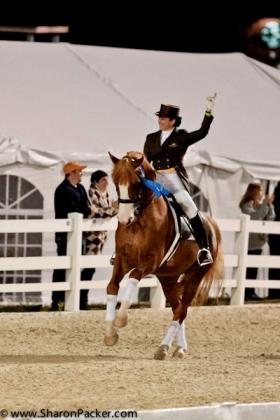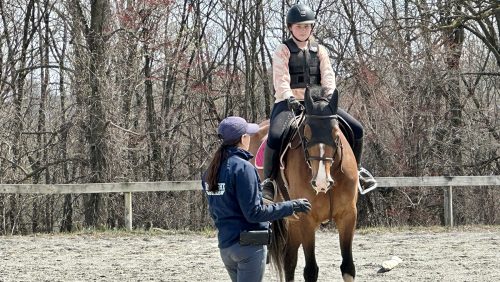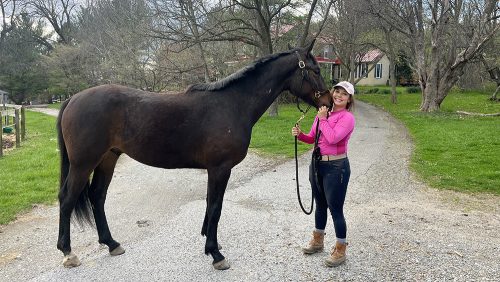Dear Rita,
We are in the midst of World Cup season, which is one of the most exciting times of year for me. World Cup is a winter tour that culminates in a Final held in March or April every year. The location of the Final is not fixed, and different countries vie for the privilege of holding it each year.
This year, the Final will be held in Leipzig, Germany, approximately four hours from my home in Vechta. This is the first time in the history of World Cup that the Final will include the three disciplines of jumping, dressage and driving all under the same roof!
I’m excited to see and hopefully participate in the Final at Leipzig. I showed at that venue in 2009 and won my first international Grand Prix there with Cadillac.
World Cup is an individual sport. Team competitions will not be held at Leipzig.
I am not familiar with the rules and qualification standards for jumping and driving, but after many years of participation in World Cup events, I can recite nearly all the FEI World Cup rules for dressage and probably direct any inquiring minds to the loopholes as well!
FEI World Cup dressage is split into four qualifying Leagues: the Western European League, Central European League, the North American League and the Pacific League. Of these leagues, the WEL is without question the most hotly contended.
Normally dominated by Dutch and German riders, the WEL hosts eight to nine qualifiers each season that stretch across the western European continent from Lyon, France, in the south to Stockholm, Sweden, in the north. Horse and rider pairs are allowed to compete in six of the events, and their top four scores count toward their final ranking in the league.
Points are earned in the WEL by placing in the Grand Prix freestyle—20 points for first place, 17 for second place, 15 for third, etc. The Grand Prix placing does not count toward the final points, but it is very important in the overall picture, especially in the WEL.
At each WEL qualifier, participants are given a starting place in the Grand Prix according to a draw. Pairs are placed into groups of five according to the World Ranking List for dressage. And believe me, Rita, even though some people in the sport will stringently deny this, it really DOES matter when/where you start in the Grand Prix and your final placing will determine where you start in the freestyle as well.
Here’s the deal. Say there are 15 starters in the Grand Prix. If you start in the first group of five amongst the lowest ranked horses and riders, a good piaffe will earn you the score of 7. A perfect halt will earn you a score of 7. One mistake in the two-tempis will earn you a score of 4. A normal extended trot will earn a score of 6.
If you get a starting place in the second group of five amongst the middle ranked horses and riders, a good piaffe MIGHT finally earn you a score of 8 if you perform it three times in a row without a mistake. A perfect halt will get you an 8 from at least two of the judges. One mistake in the two tempis will be scored between a 4 and 6 and a normal extended trot might earn you a couple of 7s.
Rita, when you have earn enough World Ranking points to land yourself in the highest ranked group at a WC qualifier, your scores will blossom! A good piaffe will earn you some 8s and possibly a 9. A perfect halt will get you some 9s for sure. In fact an imperfect halt will land you an 8 anyway! One mistake in the two-tempis will still earn you a 7, and a normal extended trot has to be an 8.
I say these things from keen observation over of a number of years.
ADVERTISEMENT
The freestyle is much the same. Because scores in the freestyle have a tendency to start around 68 percent with the first starter and go up to 80 percent by the 15th starter, you have to ride like a world champion and really impress the judges to buck this trend with an early starting place.
Freestyle starts are drawn in groups of five from the placings of the Grand Prix. Woe is the rider who lands sixth or 11th in the Grand Prix because that places you in the next lowest draw group, and you might actually be the first or sixth starter out of 15.
Because I live in Germany, I am allowed to start in the WEL as an “additional rider,” which means I am eligible to start in all the World Cup qualifiers of the League. But it also means that I have to compete against the best in the world for a start at the Final.
In the WEL, the first nine ranked combinations get to go to the Final. If I finish in that top nine this year, the FEI will nominate me for a start in the Final while still giving starts to nine other riders from the WEL, since, as an American, I can’t bump a European out of one of the nine start positions.
Each country is limited to three starters no matter what. So if the FEI awards me a Wild Card, it still has to be approved by my own national federation (USEF) before I can start in the Final. The NFs have the right to choose which riders represent their nation.
This created an interesting situation in 2007 when I was the first American in the history of World Cup to be nominated for a Wild Card by the FEI based on my performances in the WEL. The USEF protested that nomination in order to give more start places to home-based riders. Fortunately for me, the FEI held their ground in this case, and Maximus JSS and I not only got a start, but also placed seventh in the FEI Rolex World Cup Final at Las Vegas 2007.
In the North American League, which includes the USA and Canada, only the top two ranked riders are given a start at the Final. The Central European League gets two starters, the Pacific League (Australia and New Zealand) gets one. South America and Asia also have one start available if they can use it, even though these regions have not established a league. Their riders must qualify in another league.
| Western European League | 9 |
| Central European League | 2 |
| Pacific League | 1 |
| North American League | 2 |
| South America/Asia | 1 |
| WC Winner – Previous Year | 1 |
| FEI extra starting places | 2 |
| max 18 |
ADVERTISEMENT
The World Cup winner from the previous year is always granted a start place if he/she meets the minimum requirements. Since the number of starters allowed in the Final is 18, that leaves two FEI Wildcards for runners up in each league, additional riders in a league (such as myself) or riders outside the leagues who show exceptional performances. These starts are awarded by the FEI on recommendation from the Dressage Committee.
Minimum requirements for starting in the Final are two placings in Grand Prix freestyle with a score over 68 percent.
I am happy to say that Winyamaro and I have already fulfilled our minimum requirements for competing at the WC Final this year. In fact, we are at the moment ranked fourth in the WEL, behind Isabell Werth (Germany), Ulla Salzgeber(Germany) and Richard Davison (Great Britain).
In the WEL, we have four more qualifiers to go before the final rankings will be determined—Amsterdam (the Netherlands), Neumuenster (Germany), Gothenburg (Sweden) and s’Hertogenbosch (the Netherlands). W and I will probably do only two or three more of those since we also won the qualifier at Devon (USA) in October, and that score counts for one of our four highest. I hope that we can add at least one more top 10 (top five would be awesome!) placings to our final score in the league, which should help us stay in the top nine ranks of the WEL!
Any questions? Happy New Year, Rita.
I’m Catherine Haddad, and I’m sayin’ it like it is from Vechta, Germany.
Training Tip of the Day: It is difficult for top horses to compete year round. Try to give them a six to eight week break each year. Do light work during this time and keep them supple but don’t challenge them with intense work.















